Caught without a coffee bean grinder but need your fresh coffee fix? No problem. Whether you’re in your kitchen or camping in the backcountry, our guide will show you effective ways on how to grind coffee without a grinder. From the reliable mortar and pestle technique to makeshift methods involving common kitchen tools, we’ll provide you with step-by-step instructions to achieve the grind consistency needed for your next flavourful brew.
Key Takeaways
- You can get a good grind without a grinder using methods like mortar and pestle, blender, rolling pin, hammer, knife, and food processor, each requiring different techniques and precautions.
- Grind consistency is key for the perfect cup of coffee, and it varies based on the brewing method – from fine for espresso to coarse for French press – and can be controlled by the amount of beans and pressure applied.
- Alternative grinding methods like the pulse technique in blenders and food processors help achieve more even grinds, while tools like mortar and pestle provide control over grind size for flavour extraction.
Mortar and Pestle Method
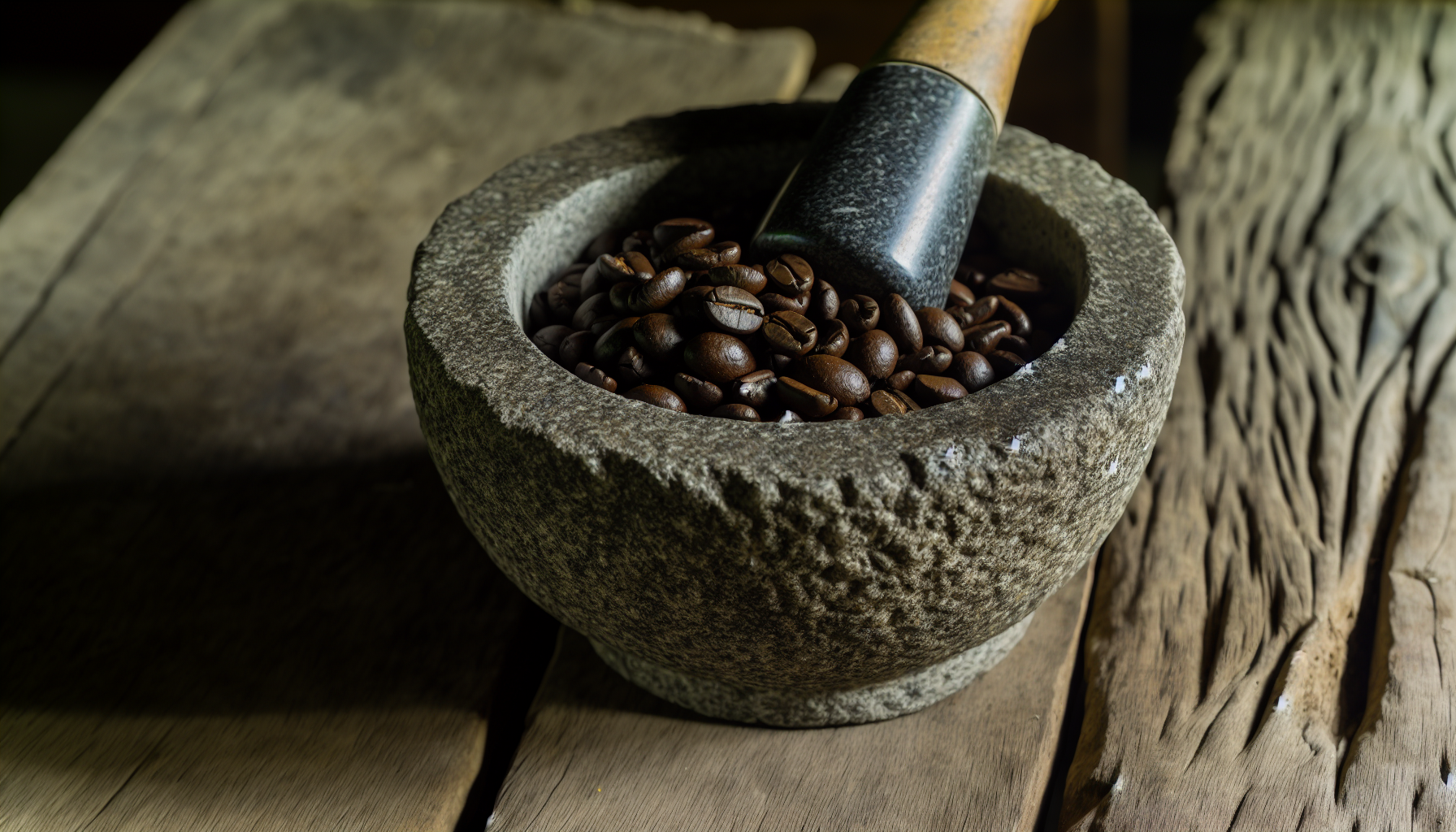
Call it old school, but grinding coffee beans using a mortar and pestle is as traditional as it gets. This method doesn’t just grind your beans, it crushes them, releasing all the flavours and aromas locked inside. Plus, it gives you absolute control over the grind size and consistency, making it a perfect choice when you’re after that fine grind for your espresso machine. However, achieving a consistent grind using a mortar and pestle requires a little bit of skill and patience. But don’t worry, we’re here to guide you through it.
Consider a ceramic mortar and pestle if you’re thinking about investing in one for grinding your beans. It delivers excellent results and aids you in achieving your preferred consistency. And remember, when it comes to grinding coffee beans with a mortar and pestle, less is more. You don’t want to overload your mortar with beans. Working in small amounts will give you a more even ground coffee.
The Process
So, how exactly do you grind coffee beans using a mortar and pestle? It’s pretty simple. Here’s a step-by-step guide:
- Start by placing the beans in the mortar.
- Hold the mortar steady with one hand and use the pestle with the other to crush the beans.
- Once you’ve broken them down, roll the pestle around the mortar. This will grind the beans into a fine powder.
- Keep going until you’ve achieved your desired grind size.
Making espresso requires a finer grind, which necessitates a bit more effort. Put some muscle into it and crush the beans with a twisting motion. Keep rolling the pestle around the mortar in a firm, circular motion until you get the desired grind size.
A coarser grind, on the other hand, is required for a French press. In this case, be gentle with your beans. You don’t want to crush them into a fine powder. To ensure a consistent grind, start by smashing the whole beans into smaller pieces before grinding them in a circular motion.
Pros and Cons
Like everything else, the mortar and pestle method has its pros and cons. On the plus side, it gives you total control over the grind size. You can go from coarse French Press grounds to super fine grounds suited for espresso. However, achieving an evenly ground coffee can be a bit challenging. You might find that the grind size can end up all over the place, affecting the flavour and aroma of your coffee.
The good news is, cleaning up is pretty simple. Just give your mortar and pestle a good rinse with warm water, and you’re done. Remember, no soap. And as for efficiency? Well, you can get your perfect grind in about 15 seconds, so that’s pretty efficient.
Blender Technique
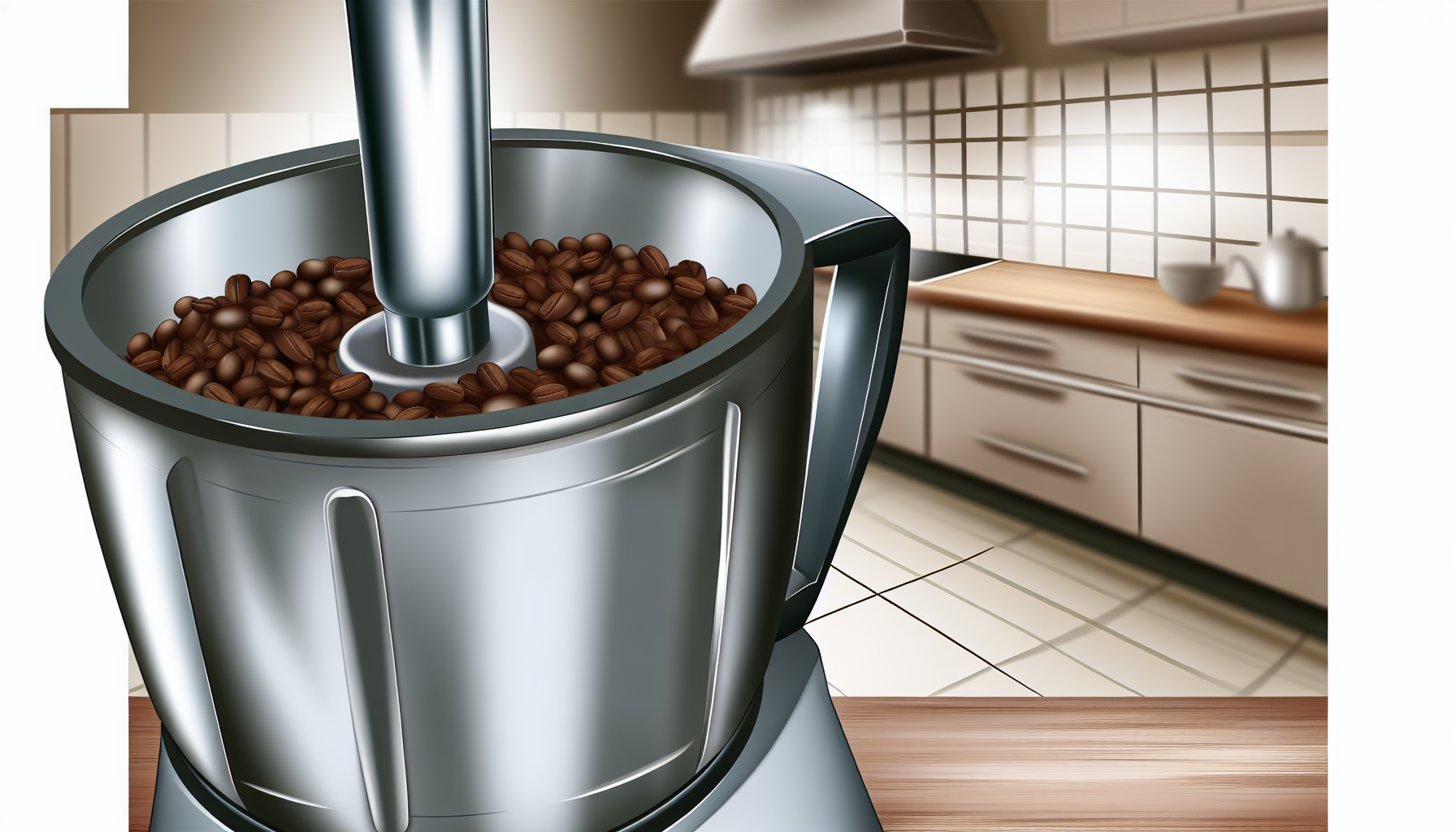
Next up is the blender technique, an alternative method that uses your ordinary kitchen blender to grind coffee beans. Using the blender’s blade system, you can chop up the beans much like a regular coffee grinder. But before you rush off to try this method, keep in mind that it comes with its own set of challenges. The main one being the risk of overheating the beans’ natural oils, which can result in a harsh and bitter tasting cup of coffee.
But don’t let this deter you. With some care and attention to detail, you can use a blender to grind your coffee beans effectively. For instance, most Ninja blenders and the Magic Bullet blender have enough power to grind coffee beans efficiently. But how exactly do you do it? Let’s go through the guide step by step.
Step-by-Step Guide
Grinding coffee beans using a blender involves a simple process. Start by adding your beans to the blender. Remember, don’t go overboard. You don’t want to overfill your blender. A good rule of thumb is to add about 1/4 cup to 1/2 cup of beans at a time.
Once you have your beans in the blender, it’s all about the pulsing technique. Instead of running your blender non-stop, pulse it in short bursts. This prevents your beans from overheating and helps you achieve a more even grind. Keep pulsing in two-second bursts for about 10 seconds, then add the next quarter of beans and repeat the process until you have the right amount of coffee and the right texture. Remember, the goal is to grind your beans for no more than 20 to 30 seconds to prevent over-processing the coffee.
Best Practices
Knowing how to grind coffee beans using a blender, it’s time to go over some best practices. Start by selecting the right container. A tall and narrow one works best for grinding coffee beans in a blender.
Next, remember to pulse blend your coffee beans in short bursts. Start with 20 to 30 seconds at first, then check the grind. If it’s not coarse enough, keep pulsing in 10-second spurts until you achieve the desired coarseness.
Also, be mindful not to overdo it. Overloading your blender with beans and blending for too long can result in burnt beans and a bitter coffee.
Finally, make sure to aim for a grind that is relatively coarse in texture. This will give your recipe the desired consistency and flavour. Adjust the blending duration until you get the coarseness you’re after. If you don’t know how to use a coffee grinder, this blog is really going to help you out!
Rolling Pin Method
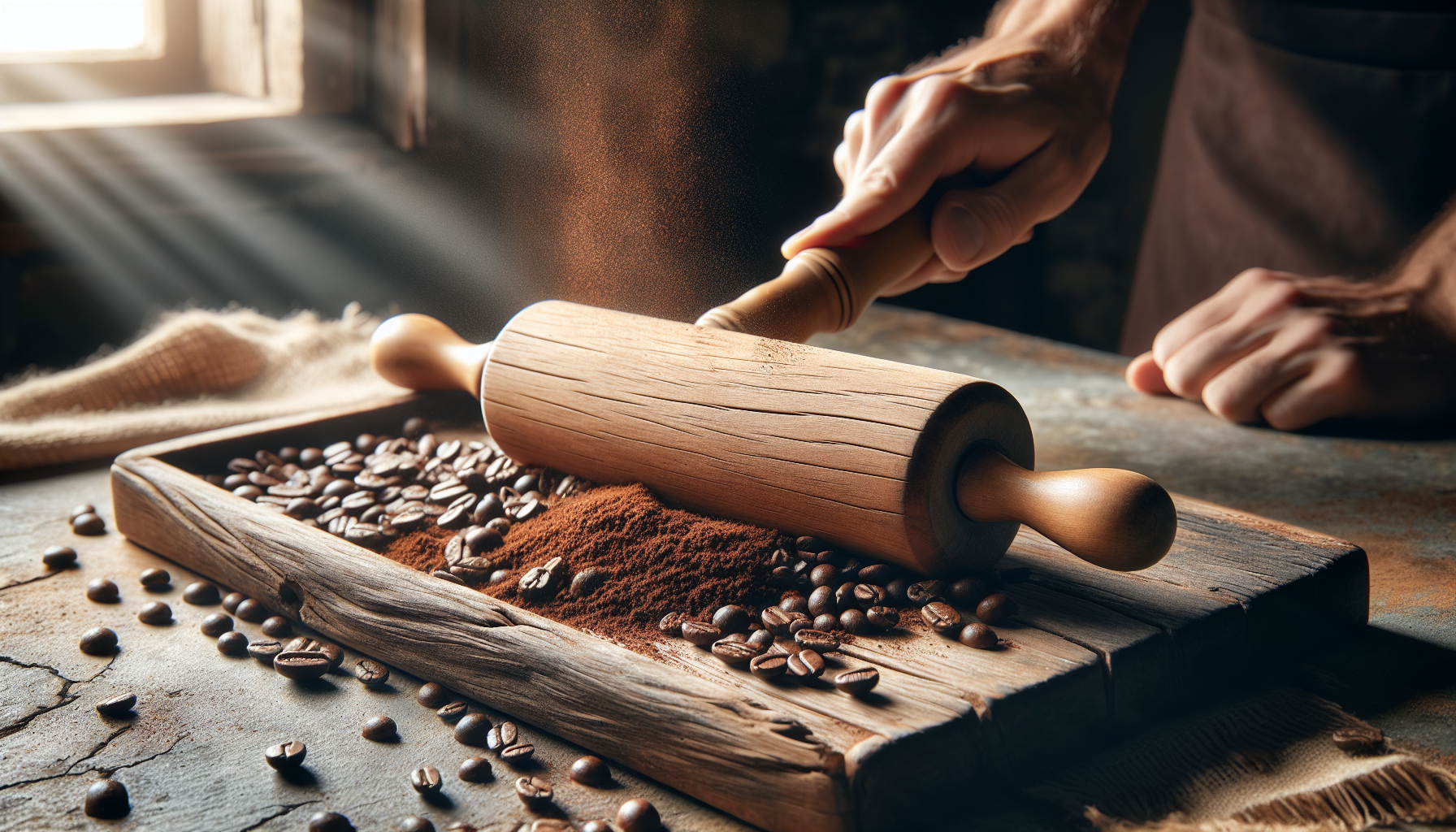
If you’re looking for a hands-on method to grind your coffee beans, the rolling pin method is for you. This method crushes and grinds the beans simultaneously, offering a unique way to achieve your desired grind. All you need is a rolling pin and a flat surface, and you’re ready to grind. Sounds simple, right? Let’s delve deeper to understand the intricacies of this method.
The rolling pin method works best on a flat surface. The key here is to press down gently but firmly and roll the pin back and forth until you achieve your preferred consistency. However, just like with the other methods, this one also requires a bit of elbow grease. But with a little patience and practice, you can master this technique and enjoy a fresh cup of brew right in the comfort of your home.
How It Works
How does the rolling pin method work, exactly? Think of it as a combination of crushing and grinding. Here’s how to do it:
- Place your coffee beans on a flat surface.
- Lay the rolling pin on top of the beans.
- Press down hard to crush them.
- This initial crushing breaks down the beans into smaller, more manageable pieces.
Once you’ve successfully crushed your beans, it’s time to grind. Grinding the beans is pretty straightforward. Using the rolling pin, you apply pressure and roll it back and forth over the beans. The key here is to apply even pressure as you roll the pin. This helps ensure that all the beans are ground to the same size, giving you a more consistent grind.
And there you have it, a fresh batch of ground coffee, ready for brewing, made from the finest whole bean coffee.
Tips for Success
To achieve a successful grind using the rolling pin method, you need to remember a few key tips:
- Always use a flat surface. This provides a stable base for crushing and grinding your beans.
- Apply even pressure as you roll the pin. This helps maintain an even grind size across all the beans.
- Keep an eye on the grind size. The rolling pin method usually achieves medium coarse grinds, which work perfectly for French press brewing.
If you prefer other brewing methods, an adjustment in your technique might be needed to obtain a finer or coarser grind.
Hammer Time
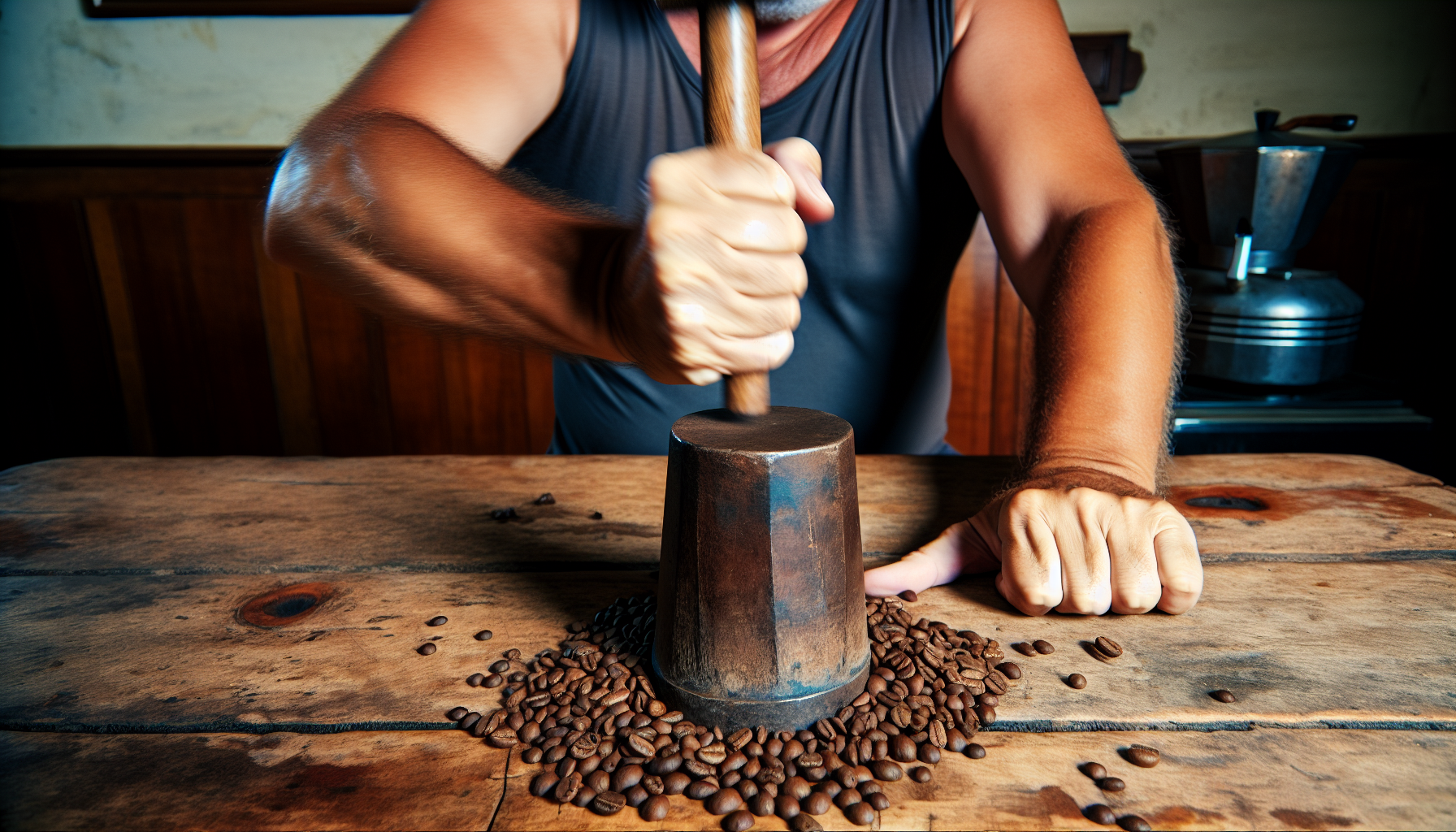
If you’re looking for a simple yet effective method to grind coffee beans, then it’s hammer time! This method involves using a mallet, hammer, or meat tenderiser to crush and grind your beans. It’s an excellent way to achieve a coarse to medium grind, and it can be quite satisfying too. But before you start swinging, it’s crucial to choose the right hammer for the job.
Finding the right hammer for grinding coffee beans can make a big difference in the outcome. From Claw Hammers to Sledge Hammers, each type of hammer can offer a different grind consistency and texture. When using this method, safety is paramount. You’ll need to ensure that the beans are placed in a plastic bag or wrapped in parchment paper to prevent them from scattering as you hammer away.
The Process
Grinding coffee beans using a hammer involves a straightforward process. Start by placing your beans in a plastic bag or between two sheets of parchment paper. This will not only contain the beans as you hammer but also prevent any pieces from flying out. Once your beans are securely placed, it’s time to start hammering.
When hammering, start by pressing down evenly to crush the beans. This initial crushing breaks the beans into smaller pieces, making them easier to grind. Once the beans are crushed, you can start grinding. Apply controlled force with the hammer to crush the beans until you achieve the desired grind size. Remember, your goal is to achieve a grind size that matches your brewing method.
Grind Sizes Achievable
Using a hammer to grind coffee beans offers a range of grind sizes. From fine to coarse, you can achieve different grind sizes based on the force you apply and the duration of your hammering. However, achieving an evenly ground coffee using a hammer can be challenging. You might find that the grind size can vary, affecting the flavour and aroma of your coffee.
But with a systematic approach and careful attention, you can achieve a consistent grind size using a hammer. Just remember to press down evenly and move systematically from one side of the bag to the other to ensure an even texture.
Knife Skills
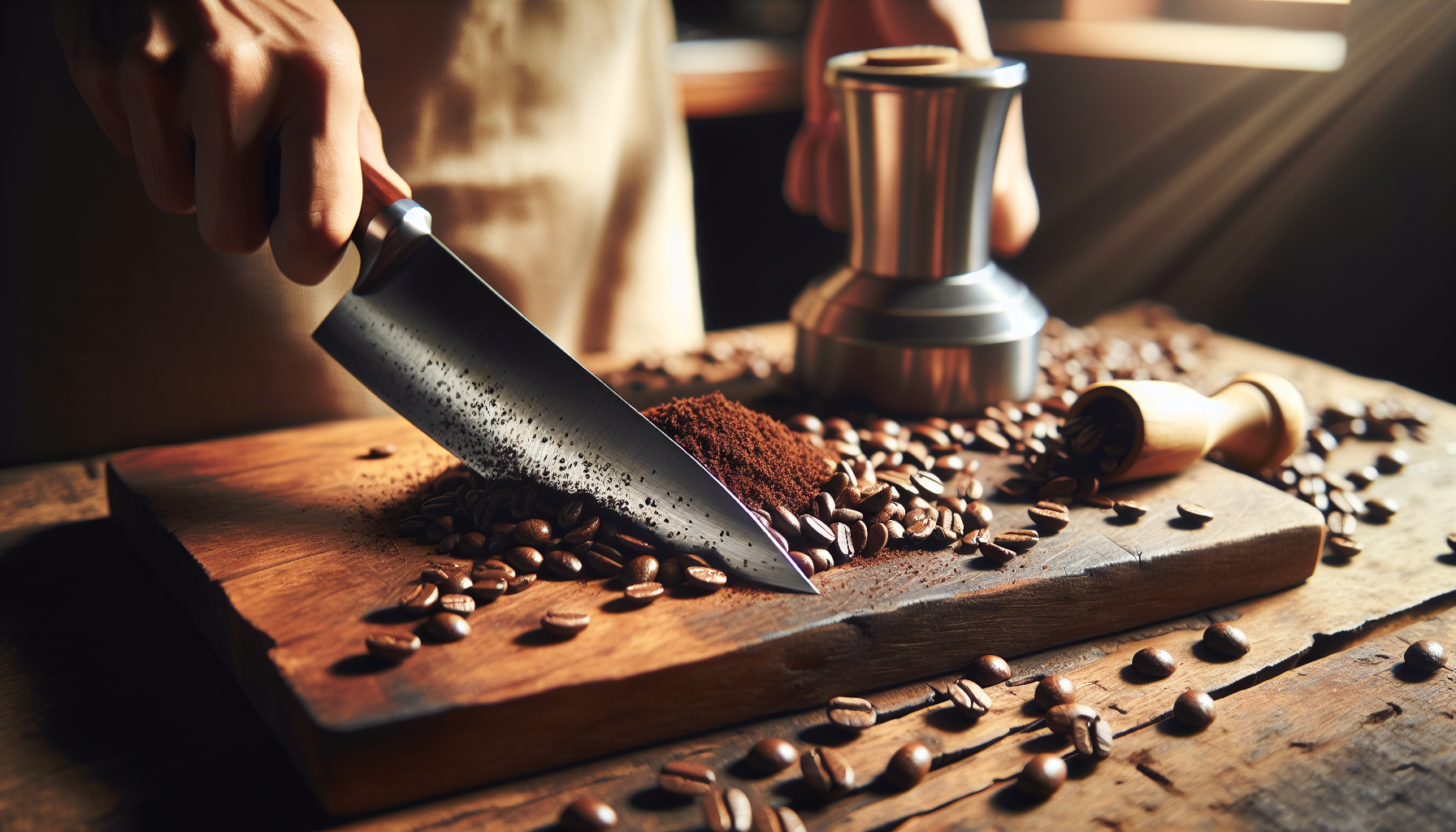
If you’re comfortable with a knife, then the knife skills method might be the perfect way for you to grind your coffee beans. This method involves using a knife to chop and grind the beans, offering a unique way to achieve a medium to medium-fine grind. The key to this method is choosing the right knife. A butcher knife or a chef’s knife with a slightly wider and stiffer blade would be ideal for this task.
However, grinding coffee beans using a knife requires a certain level of skill and caution. The blades can easily overheat the beans, resulting in a burnt taste. But with the right technique and a good amount of patience, you can master this method and enjoy a fresh cup of coffee anytime.
Technique Explained
The knife grinding technique revolves around using the flat of the blade. But how does it work? Here are the steps:
- Start by placing your beans on a cutting board.
- Then, lay the knife flat on the beans and press down hard to crush them. This initial crushing breaks the beans into smaller, more manageable pieces.
- Once you’ve successfully crushed your beans, it’s time to grind beans using the knife grinding technique.
Grinding the beans involves using the flat of the blade to crush the beans further. Press down with the knife until they’re crushed to the size you want. Remember, your goal is to achieve a grind size that matches your brewing method. So, keep an eye on the grind size as you go along.
Choosing the Right Knife
Choosing the right knife for grinding coffee beans is crucial. A high-speed blade grinder that can chop the beans well is your best bet. Some of the best options include conical burr grinders and burr coffee grinders.
You can also use a chef’s knife or a paring knife to prepare beans without a grinder, specifically with a blade grinder. However, avoid using a serrated knife as it tends to slice and shave the beans, resulting in an uneven brew quality.
Food Processor Finesse
Last but not least, we have the food processor finesse. This method uses your everyday kitchen food processor to grind coffee beans without a dedicated grinder. While it may not give you the perfect consistency, it’s a convenient method when you need to grind a decent amount of beans in a pinch.
Before you start, it’s important to note that the food processor method is best suited for achieving a medium-fine grind. This grind size works great for pour over brew methods, which can handle this grind size and consistency well.
Let’s delve into the details of how coffee beans can be ground using a food processor.
The Pulse Technique
The pulse technique is the key to using a food processor for grinding coffee beans effectively. This technique involves grinding in short bursts and shaking the food processor in between, instead of just grinding continuously. By pulsing and shaking the food processor, you get more control over the grind size, which helps to make the grind more even.
Start by placing your beans in the food processor. Remember not to overfill it. You want to add just enough beans to cover the blades. Once you have your beans in the food processor, it’s all about the pulsing technique. Pulse the processor in short bursts for about 15 seconds each to prevent overheating and to achieve a consistent grind size.
When to Use This Method
Aiming for an even grind for your coffee? The blender or food processor method could be the ideal choice. The wider bowl of the food processor helps the beans move around more freely, resulting in a more consistent grind compared to using a blender or other methods. Plus, grinding your beans using a food processor can enhance their flavours and aromas, making your coffee taste even better.
So, when you are in a rush next time, try this drip coffee method and relish a fresh cup of coffee.
Grind Consistency and Brewing Methods
The consistency of your grind plays a crucial role in the taste and quality of your coffee. Different brewing methods require different grind sizes to extract the flavours and aromas effectively. But achieving a consistent grind without a coffee grinder can be a challenge. Fret not! We have some tips to help you achieve a consistent grind using alternative grinding methods.
To achieve the best grind for your coffee, follow these tips:
- Grind or crush only a few beans at a time for a more evenly ground coffee.
- Monitor the grind size closely and adjust your techniques as needed to achieve the grind size that matches your brewing method.
- Whether you’re using a French press or making espresso, the grind size plays a crucial role in the quality of your brew.
Matching Grind Size to Brewing Method
Each brewing method extracts flavours from the coffee beans in its own unique way, requiring different grind sizes for optimal results. For instance, espresso requires a fine grind due to the high pressure and fast brewing time. On the other hand, French press coffee brewing requires a coarser grind to prevent over-extraction and bitterness.
For cold brew coffee, a medium-coarse to coarse grind size is recommended. This is because cold brew involves a longer steeping time, which can lead to over-extraction if the grind is too fine. If you’re using an Aeropress, a medium-fine grind size is ideal. It allows for optimal extraction of flavor compounds, resulting in a balanced and flavourful cup of coffee.
Tips for Better Consistency
When grinding coffee beans, consistency is paramount. Here are a few tips to help you achieve a better grind consistency using alternative grinding methods. When using blenders or food processors, pulse in short bursts instead of running continuously. This helps prevent the beans from overheating and ensures a more consistent grind.
If you’re using a rolling pin, apply even pressure and roll back and forth until you achieve your preferred consistency. And remember, practice makes perfect. The more you grind, the better you’ll get at achieving the perfect grind consistency for your favorite brew.
Summary
The journey to the perfect cup of coffee starts with grinding your beans. Maybe your coffee grinder has not lasted as long as you thought and you’re stuck without a working grinder. While a coffee grinder is the ideal tool for this task, there are plenty of other ways to grind coffee beans without a grinder. From the traditional mortar and pestle method to the handy food processor finesse, each method has its pros and cons. But with the right technique, patience, and a bit of practice, you can achieve the desired grind consistency for your favorite brew.
In conclusion, grinding your own coffee beans is not just about the fresh taste and aroma. It’s also about the process, the art, and the satisfaction of knowing that you’ve created your perfect cup of coffee from scratch. So, go ahead and experiment with these methods and find your personal favorite. After all, a good day starts with a good cup of coffee.
Frequently Asked Questions
How can you grind coffee without a coffee grinder?
Yes, you can grind coffee without a grinder by using a blender, food processor, or grinding by hand with tools like a hammer, mortar and pestle, hand mincer, or rolling pin. It’s possible to adjust the grind to your desired coarseness with these methods.
Can you use a blender to grind coffee beans?
Yes, you can use a blender to grind coffee beans. Use the ‘pulse’ setting to achieve a consistent grind at home (Today).
How to grind?
When grinding, make circular motions while leaning left and right. Keep the movement consistent to get the desired result.
Can I grind coffee beans without a coffee grinder?
Yes, you can grind coffee beans without a coffee grinder by using alternative methods such as a mortar and pestle, blender, rolling pin, hammer, or knife, each offering different grind sizes and consistency. Try one that suits your preference!
Which method is the best for grinding coffee beans without a grinder?
The best method for grinding coffee beans without a grinder depends on your preference, the tools you have, and the brewing method you’ll use. For a fine grind, consider using a mortar and pestle, while a rolling pin or hammer is suitable for a coarser grind.


